Product Spotlight – Shamir Glacier Plus UV
CLIMATE CHANGE WE CAN ALL AGREE ON – improving AR sales
By Rollie Stenson, ABOC and Mark Mattison-Shupnick, ABOM
Release Date: October 1, 2016
Expiration Date: November 1, 2017
Learning Objectives:
Upon completion of this program, the participant should be able to:
- When technology changes, it provides the platform to change behavior, understand the effects that improved AR can have on an independent practice.
- Learn the new technology that makes a Glacier Plus UV AR lens.
- Be able to communicate the customer benefits and turn those words into increased AR percentages within the practice that also exceeds patient satisfaction.
Course Description:
Climate change, now that can start a heated discussion about technologies role. However, technology in optical provides real benefits for wearers, especially in AR lenses. That means that whatever your percent penetration of AR is, new technologies warrant that it could probably be more. What's your current usage, are you using the best of AR technologies and how do you choose the right lenses? Read this course and product spotlight. Then, have a think about the best ways to understand new AR and then the best ways to incorporate them into your practice.
Faculty/Editorial Board:
Rollie Stenson, ABOC and Mark Mattison-Shupnick, ABOM
Credit Statement:
This course is approved for one (1) hour of CE credit by the American Board of Opticianry (ABO). Course SWJH561
This course is supported by and educational grant from Shamir.
BIG CHANGES IN THE AR CLIMATE
Improvements in the visual performance of eyeglass lenses as the result of technological advances are like climate change: incremental and sometimes only barely perceptible, but occasionally quite dramatic. How well your customers see is clearly within your scope of practice and improving visual performance by embracing technology is the right thing to do. Like putting tires on a car, a high quality anti-reflective coating should be a part of every new set of eyewear for optimal performance, convenience, and durability.
TSUNAMI-LIKE GROWTH POTENTIAL
While the practice management software from Glimpse1 reported AR usage among their data hungry subscribers at 62%, Vision Watch reported a much lower 30% AR usage as reported by consumers. It's likely that a good portion of the consumers responding to the VW survey either did not know what an anti-reflective lens is or whether it was a part of their last eyewear purchase, so the percentage of lenses dispensed may be closer to 40% give or take. If you don't know your current AR percentage, your optical lab can supply the data or you can do a tally over a reasonable time period (30-90 days). Wherever your practice lands, - low, medium, or high - unless you are providing AR 100% of the time, there is room for growth. Realistic sales percentages of 80% or better proliferate the eye care marketplace from boutiques to big-box retailers, so if your AR percentage is below that mark, let's analyze why and consider some changes that will benefit your patients and your practice.
WHO SHOULD HAVE AR?
This is easy to answer. Everybody should have a quality anti-reflective coating on his or her eyeglass lenses. Without exception, the optical performance of a lens (Rx or not) is improved with the application of thin layer coatings (affectionately named destructive interference) allowing almost all of the visible light to pass through the lens to the wearer's eyes. This reduces annoying and confusing reflections on the lens' surface as well as the interior of the lens. If optical performance were the number one criteria for including an "option", AR coatings would win hands down.
But, it's not that simple. For the best AR today, every step in the AR process including the lens that you start with is key to the final AR lens and its performance. Then, the application of freeform calculations and cutting technologies allow for clearer vision edge to edge with the evolution of AR ensure that clarity is uncompromised while it offers additional consumer protections. This product spotlight CE focuses on Shamir Glacier Plus UV. It provides dispensers with an AR lens that considers the AR, from the lens up. That kind of forethought requires no apologies and delivers a rich list of benefits that meet every consumer's no hassle want for their eyewear.
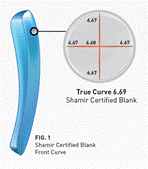 AR, NOT JUST ON ANY LENS
AR, NOT JUST ON ANY LENS
Bet you thought that any semi-finished lens could be the right lens for free-from. Actually it's not the case. Think about the process of optimizing or personalizing the lens' prescription. The calculation engine starts with the actual front surface curve. When lenses are cast or molded, there are changes to the final surface curvature depending on lens material, curing and shrinkage rates, mold thicknesses (glass molds bent during the curing process) and the uniformity of the molds surface curvature, edge to edge. As a result, the uniformity of the substrate's front surface may be different at the center than the edges.
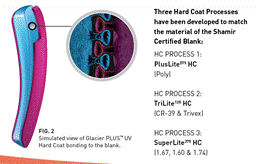 When producing the back lens curve for an optimized or personalized freeform lens (SV or progressive), the calculation engine assumes that the front curve is the front curve, everywhere. The calculations produce thousands of surface heights joined together to form the back surface AND to deliver the vision that is intended with the freeform at all those thousands of points on the lens. That's why optimized and personalized freeform lenses 'see' better. So, one would get better lenses if the front surface were guaranteed to be the same (within very tight tolerances) from edge to edge. So, to make an AR lens as clear visually as possible, Shamir Glacier Plus UV lenses start with a Shamir Certified Blank i.e., the front surface is more consistent when it comes to the lens design (Fig 1).
When producing the back lens curve for an optimized or personalized freeform lens (SV or progressive), the calculation engine assumes that the front curve is the front curve, everywhere. The calculations produce thousands of surface heights joined together to form the back surface AND to deliver the vision that is intended with the freeform at all those thousands of points on the lens. That's why optimized and personalized freeform lenses 'see' better. So, one would get better lenses if the front surface were guaranteed to be the same (within very tight tolerances) from edge to edge. So, to make an AR lens as clear visually as possible, Shamir Glacier Plus UV lenses start with a Shamir Certified Blank i.e., the front surface is more consistent when it comes to the lens design (Fig 1).
If we continue this thought that everything we do to the lens affects the wearer's vision then to make the clearest lenses visually, how can we improve every step? Next, the hardcoat is applied, the basis for the lens' overall scratch resistance and durability. That's pretty well understood but not all hardcoats are super hard. Also, not all AR lenses use material matched hardcoats i.e., where the index of the hard coat and the substrate are virtually the same.
There are three hardcoat processes that molecularly bond the hardcoat to the lens substrate (Fig 2.). The three coatings are grouped based on material chemistry and index. The chemistry and bond help to produce a very hard surface to then apply the AR stack. However, you've seen the affect of an index mis-matched hardcoats. Newton ring reflections appear like waves when looking at the lens. If the hardcoat index were tuned to lens material (a typically more expensive coating material), those rings disappear (Fig 3.). The result is a lens is clearer and looks better.
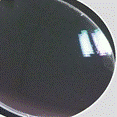 |
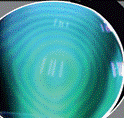 |
| Fig 3. Shamir Glacier Plus UV compared to an index-mismatched hardcoat. Both coatings were applied to the same type of lens to illustrate the comparison. | |
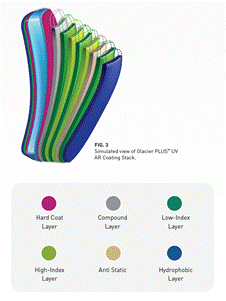 Next, the stack i.e., the number of and kind of vacuum deposited layers that create anti-reflective properties to improve transmission is typically a proprietary recipe. This illustration (Fig 4.) shows the layers as follows starting at the lens (light blue), then hardcoat, a compound layer for durability and adhesion, low index, high index, low index, anti-static, high index, finally the hydrophobic layer. Interleaving of the indices is what creates the anti-reflective property.
Next, the stack i.e., the number of and kind of vacuum deposited layers that create anti-reflective properties to improve transmission is typically a proprietary recipe. This illustration (Fig 4.) shows the layers as follows starting at the lens (light blue), then hardcoat, a compound layer for durability and adhesion, low index, high index, low index, anti-static, high index, finally the hydrophobic layer. Interleaving of the indices is what creates the anti-reflective property.
The combination of technologies are combined into a set of composite properties i.e., the result of each interacting with the other for a final result better than the individual properties of each part. This delivers a scratch resistant (abrasion and scratches), thin (bends with the lens as it expands or contracts to avoid crazing), glare reducing (virtually all light passes through), slippery (easy to clean), durable (terrific value), anti-static (stays clean), for the best acuity (ensures that the best of freeform capability). Phew!
Now, let's talk about the back surface – should be the same as the front but as it turns out, todays' better AR are complex mixtures of different coatings. AR on the lens front allows UV through so that if applied to photochromics, the UV needed to activate the lens is not hindered. The lens substrate's job then is to be 100% UV protective. Back AR though was often formulated differently. Some lenses were factory hardcoated on the front and after surfacing had a spin on back surface hardcoat, then AR. The result may be one that reflects UV rather than not.
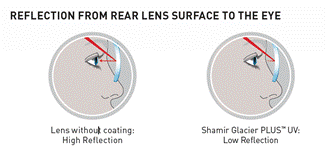 In a paper published in 2008, K. Citek OD found that back surface AR reflects UV1. For the back of a lens that can become an accumulated problem. From Eye and Contact Lens, David Sliney PhD., wrote, "The risk of excess UV exposure of the germinative cells of the lens is greatest from the side. Sunglasses can actually increase UV exposure of the germinative region of the crystalline lens and the corneal limbus by disabling the eyes' natural protective mechanisms of lid closure and pupil constriction! The level of UV-A risk is difficult to define." While this paper describes the efficacy of UV absorbing contact lenses and wrap sunglasses for the side light effect, it and the Citek paper highlights, for the authors, the problem of lenses that are also UV reflecting off the back surface. Sunwear especially, increases the size and brightness of back surface reflections. As a result, the back surface of the AR lens should be made so that it reduces UV reflections, either in clear, photochromic or sunlenses.
In a paper published in 2008, K. Citek OD found that back surface AR reflects UV1. For the back of a lens that can become an accumulated problem. From Eye and Contact Lens, David Sliney PhD., wrote, "The risk of excess UV exposure of the germinative cells of the lens is greatest from the side. Sunglasses can actually increase UV exposure of the germinative region of the crystalline lens and the corneal limbus by disabling the eyes' natural protective mechanisms of lid closure and pupil constriction! The level of UV-A risk is difficult to define." While this paper describes the efficacy of UV absorbing contact lenses and wrap sunglasses for the side light effect, it and the Citek paper highlights, for the authors, the problem of lenses that are also UV reflecting off the back surface. Sunwear especially, increases the size and brightness of back surface reflections. As a result, the back surface of the AR lens should be made so that it reduces UV reflections, either in clear, photochromic or sunlenses.
1. Citek, Karl, "Anti-reflective coatings reflect ultraviolet radiation" (2008). Faculty Scholarship (COO), Paper 5, http://commons.pacificu.edu/coofac/5)
2. Eye Contact Lens, Intraocular and crystalline lens protection from ultraviolet damage, D. Sliney PhD., 2011 Jul;37(4):250-8
ENDURING AN ICE AGE: WHY ARE YOUR AR SALES UNDER 80%?
The most common reason given by dispensers and doctors for not selling more anti-reflective lenses is:
- They do not feel their customers are willing to pay an additional charge for an option. There is no denying cost is a factor in every consumer transaction.
- Both dispensers and consumers cite unreliable previous product performance as a reason to refuse the offer to purchase AR lenses. A bad experience in the past carries a great deal of emotion and keeps humans from making the same mistake twice.
- Many dispensers are overwhelmed in their role in the eye care office and find both the product and sales presentation too complicated to properly communicate to their patients in the short time they have between tasks.
- In spite of all the education and science explaining the visual benefits of anti-reflective lenses, there are still hold-outs at retail that believe AR lenses are just a ploy to increase add-on's to the consumer and beef up the lab bills.
To achieve a change in behavior, you must first change an attitude, so before moving into how to successfully present new AR, ask yourself this revealing question: How well do you want your patients to see? If all you are concerned with achieving 20/20 acuity, any online eyeglass site can provide that and at a lower cost than your office. But if you are convinced there is more to vision than acuity, that the quality of your customers' vision can be enhanced through the use of appropriate technologies, then let's move along to the next section.
COMMUNICATE, GLACIER PLUS UV, AR LENS ADVANTAGES
To summarize the advantages of this new AR, translate the technology into patient benefits, communicate them simply to each patient. For example, say:
- "Improved scratch resistance protects your lenses when it comes to your daily activities."
- "Lenses are easy and effortless to clean."
- "Enhanced anti-static properties repel dust."
- 'Protects your eyes with backside UV protection."
- "Dramatically reduces annoying "rainbows", for a clear view of your eyes."
- "Reduces "visual glare" for a safer driving experience, especially at night."
- 'Prevents distracting "cosmetic glare" when someone is looking at you."
Remember that new product technologies are to your advantage, Now let's get back to see how we can use them to get to 80% AR.
WE'RE HAVING A HEAT WAVE: ACHIEVING SALES OF AR 80%
If you find yourself having to defend and explain the cost of AR lenses to your customers, determine first your level of belief in this product. Any question regarding the value of the new technologies presented should be considered in light of how it affects your customers' vision, convenience, and lens durability. Any doubts should be easily squared away by the previous technical discussion of this product. What it costs is not nearly as important as the value it brings to the consumer.
Your pricing structure and strategy must line up with customer value. If you feel your price for a product is too high, so will your customers. This requires some adjustment of thinking. Or, perhaps a new twist in your approach to pricing in general is required. Many practices still adhere to the "Keystone" approach to consumer pricing i.e., retail is double the wholesale lab price. As an example, an AR at $49 from the lab is offered to a retail customer for $98. Nice and clean, but does it properly reflect the value of the AR? Maybe clarity, convenience, and durability are worth an additional $98 and maybe it is not. If only 30% of your customers think it is worth it, perhaps, as an add-on, it doesn't seem worth the cost to 70% of your customers.
The other part about pricing to consider is the time and cost of lenses replaced for customer dissatisfaction. If the profit is small, then you'll be reticent about changing lenses. I'm not suggesting out of line profit but the patient doesn't understand that not just product costs (cost of goods sold, COGS) but also all of your services and part of the overhead is wrapped into pricing. I am suggesting that there is enough of an increase in pricing so that every optician can be empowered to fix a problem without wondering whether they'll get called on the carpet for spending for lens replacements.
You can easily determine if cost is the real reason your AR percentage is below 80% by looking at how well it is embraced by your managed vision care (MVC) customers. Depending on your practice, MVC will affect pricing for up to 70% of your customers. Most plans provide the same quality AR at a lower out of pocket to the customer; if your acceptance rate is still low, the reason is probably not cost. Instead, how AR is presented could be polished up a bit to make it easier for the customer to purchase.
Explaining the concept of AR lenses is too technical for most consumers. Instead, as we suggested, Shamir Glacier Plus UV can be explained as providing better clarity, ease of cleaning, and improved scratch resistance plus important protection from UV light. And the most up-to-date anti-reflective lens goes hand-in-hand with the most advanced freeform lens designs. It all adds up to providing your customers with best vision possible in spectacle lenses.
Your credibility and the credibility of your practice is on the line; too many practitioners use this as a reason NOT to offer a new product, thinking they should wait to see how much traction it gains in the marketplace before they embrace it and "try it out" on a few select customers. Give it some thought: would it make sense for any reputable company to release a product into the market without having full confidence that it would perform as expected? You and your customers have the full support of your optical lab that also provides the patient with two years of satisfaction. It's called a promise of satisfaction and it exists because the manufacturer is sure it won't come back to bite you (or them).
If you are unsure about whether or not you should be offering new AR lenses to your customers, shop your competition. Are they providing this or a comparable to their customers? How about online providers? You can be sure online eyeglass retailers provide substantial information about the value of anti-reflective lenses to their customers. And you should be aware that more and more of your customers are gathering information, some shopping online for eyeglasses before they visit your office. As you know, not all lenses are the same and that is especially true of AR. Don't lose credibility by being slow to offer AR with additional benefits. It will set you apart as a leader in this category.
SHAMIR GLACIER PLUS UV: BEST PRACTICES
The best way to sell new AR is to wear it! Don't wait until next year when you get a new prescription. Have a pair made up right away so you can put it on your smiling face and give you a reason to say, "I love my new glasses! I wouldn't have glasses without newer AR lenses, here's why…" Let your passion show! Wearing the most advance lens technologies and frame designs is the best way to showcase them, And make sure everyone in the office has the same opportunity to provide spontaneous testimonials to the clarity, convenience, and durability. Convince the practice owner to supply the staff with up-to-date, high tech eyewear. It's a small investment in the best kind of marketing.
It certainly makes sense to use whatever demonstration items and printed materials your lab or lens rep makes available. Most optical labs will supply you with a pair of demo glasses with one AR lens and the other not. Ask them to use new Shamir Glacier Plus UV so you can demonstrate not only the clarity, but also how durable and how easy they are to clean. Don't forget to mention the two-year warranty. It indicates your confidence in this spectacular product. Will anyone take advantage of the warranty one year and three hundred sixty-four days after the purchase? Some will; most won't. Don't sweat the small stuff.
Another option you should consider is to make the latest AR standard equipment rather than an add-on. In some markets lenses are not easily available without AR and in fact may cost more. Would you expect to pay more for tires on a new car or would they be included as standard equipment? If you are a practice focused on the latest technology, making AR standard on every set of lenses should make sense. As you develop a new lens strategy, bundle high tech products into a "Good, Better, Best" formulary that always includes AR because of its profound effect on clarity, convenience, and durability.
Another approach is to include a new AR like Shamir Glacier Plus UV as standard and already included in all lens prices. Some offices may be satisfied with a lower margin (cost times 2) so that the overall pricing is palatable. If a patient opts not to purchase the AR Package, the price to the customer is reduced by only $25-$50. It isn't enough of a reduction for most consumers to go for, especially if you've done a good job of passionately presenting it. Take less margin on increased sales. Do the math.
OUTLIERS: WHEN IS AR NOT A GOOD FIT?
It's a given that not everyone will purchase a quality AR. But that doesn't mean they shouldn't consider including AR with their nightstand readers, back up glasses, safety glasses, sunglasses, or children's eyeglasses. Really? When exactly should we deprive our customers of the best vision possible? When should their lenses be harder to clean and easier to scratch? I think you see my point. However, every once in awhile, a customer will dislike how clear the lenses actually are and want to take away the AR. Oh yeah, don't forget to mention the warranty.
BOTTOM LINE: KEEP IT SIMPLE!
Create a script that fits your strategy that is short and easy to present such as, "The doctor and I recommend completing your lenses with Shamir Glacier Plus UV to give you the best possible vision and protection; make your lenses more durable, more UV protective and easier to keep clean."
From your perspective, providing the best vision possible is the right thing to do, and new technology AR like Shamir Glacier Plus UV unquestionably enhances the optical performance of spectacle lenses. After all, if AR was not important in terms of visual performance, why is it on ALL surgical microscopes, binoculars, telescopes, and camera lenses?
Achieving 80-90% AR sales is possible. Like running the four-minute mile, once you meet someone who is doing it, you will understand it is possible. And, many practitioners are in this range already, both in highly insured markets and in boutique settings, in private practice and in big-box environments. The optical climate is changing, and you can contribute to this positive change.



